Arthur Murray (NSW) Pty Ltd v FCT (1965) 114 CLR 314 - Taxation Law Case Study
VerifiedAdded on 2023/06/12
|10
|2911
|191
AI Summary
This case study discusses the taxation law principles applied in Arthur Murray (NSW) Pty Ltd v FCT (1965) 114 CLR 314. It covers the issue of income derivation, accounting methods, trading stock, rental storage, long service leave payment, and tax deductions.
Contribute Materials
Your contribution can guide someone’s learning journey. Share your
documents today.
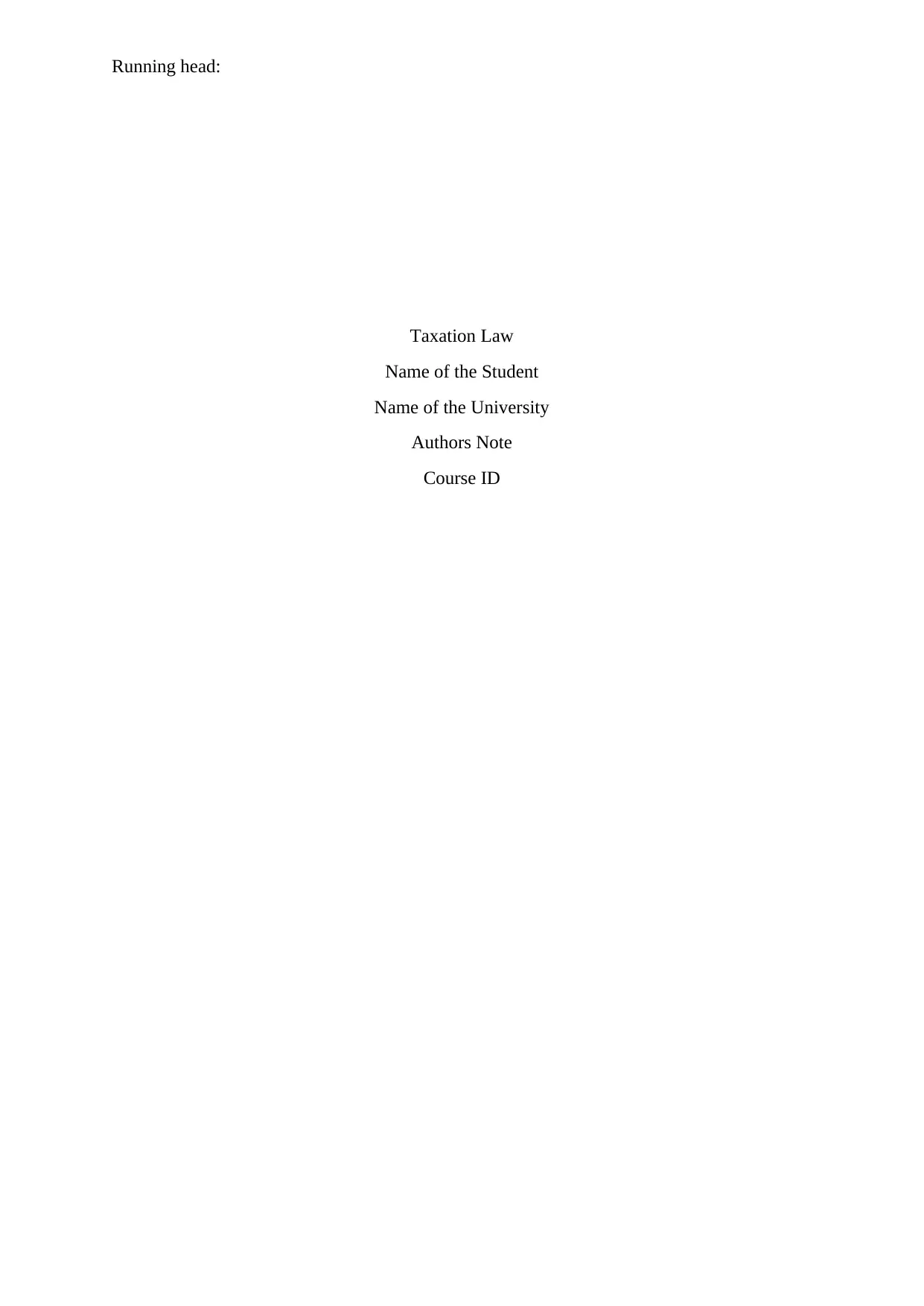
Running head:
Taxation Law
Name of the Student
Name of the University
Authors Note
Course ID
Taxation Law
Name of the Student
Name of the University
Authors Note
Course ID
Secure Best Marks with AI Grader
Need help grading? Try our AI Grader for instant feedback on your assignments.
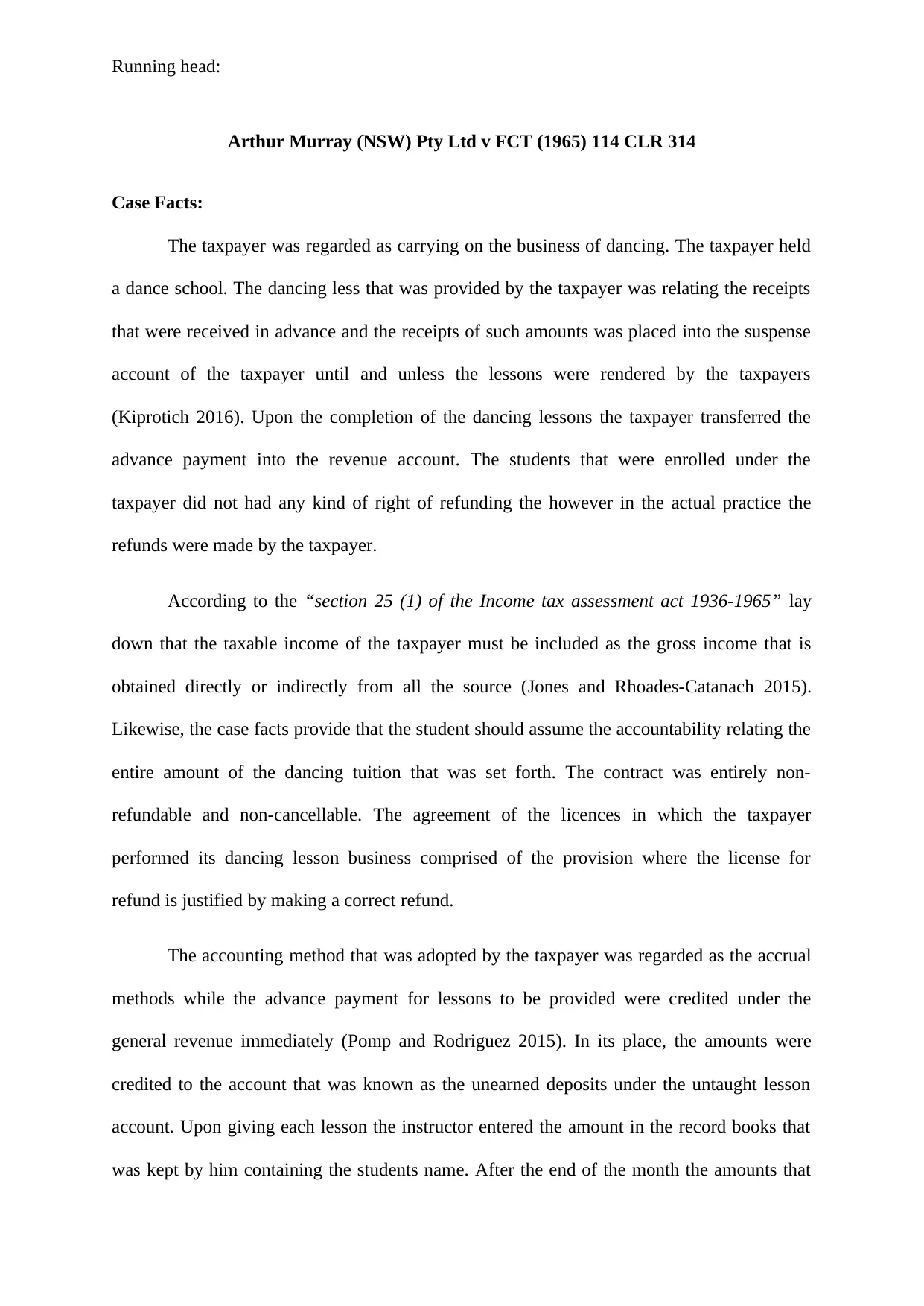
Running head:
Arthur Murray (NSW) Pty Ltd v FCT (1965) 114 CLR 314
Case Facts:
The taxpayer was regarded as carrying on the business of dancing. The taxpayer held
a dance school. The dancing less that was provided by the taxpayer was relating the receipts
that were received in advance and the receipts of such amounts was placed into the suspense
account of the taxpayer until and unless the lessons were rendered by the taxpayers
(Kiprotich 2016). Upon the completion of the dancing lessons the taxpayer transferred the
advance payment into the revenue account. The students that were enrolled under the
taxpayer did not had any kind of right of refunding the however in the actual practice the
refunds were made by the taxpayer.
According to the “section 25 (1) of the Income tax assessment act 1936-1965” lay
down that the taxable income of the taxpayer must be included as the gross income that is
obtained directly or indirectly from all the source (Jones and Rhoades-Catanach 2015).
Likewise, the case facts provide that the student should assume the accountability relating the
entire amount of the dancing tuition that was set forth. The contract was entirely non-
refundable and non-cancellable. The agreement of the licences in which the taxpayer
performed its dancing lesson business comprised of the provision where the license for
refund is justified by making a correct refund.
The accounting method that was adopted by the taxpayer was regarded as the accrual
methods while the advance payment for lessons to be provided were credited under the
general revenue immediately (Pomp and Rodriguez 2015). In its place, the amounts were
credited to the account that was known as the unearned deposits under the untaught lesson
account. Upon giving each lesson the instructor entered the amount in the record books that
was kept by him containing the students name. After the end of the month the amounts that
Arthur Murray (NSW) Pty Ltd v FCT (1965) 114 CLR 314
Case Facts:
The taxpayer was regarded as carrying on the business of dancing. The taxpayer held
a dance school. The dancing less that was provided by the taxpayer was relating the receipts
that were received in advance and the receipts of such amounts was placed into the suspense
account of the taxpayer until and unless the lessons were rendered by the taxpayers
(Kiprotich 2016). Upon the completion of the dancing lessons the taxpayer transferred the
advance payment into the revenue account. The students that were enrolled under the
taxpayer did not had any kind of right of refunding the however in the actual practice the
refunds were made by the taxpayer.
According to the “section 25 (1) of the Income tax assessment act 1936-1965” lay
down that the taxable income of the taxpayer must be included as the gross income that is
obtained directly or indirectly from all the source (Jones and Rhoades-Catanach 2015).
Likewise, the case facts provide that the student should assume the accountability relating the
entire amount of the dancing tuition that was set forth. The contract was entirely non-
refundable and non-cancellable. The agreement of the licences in which the taxpayer
performed its dancing lesson business comprised of the provision where the license for
refund is justified by making a correct refund.
The accounting method that was adopted by the taxpayer was regarded as the accrual
methods while the advance payment for lessons to be provided were credited under the
general revenue immediately (Pomp and Rodriguez 2015). In its place, the amounts were
credited to the account that was known as the unearned deposits under the untaught lesson
account. Upon giving each lesson the instructor entered the amount in the record books that
was kept by him containing the students name. After the end of the month the amounts that
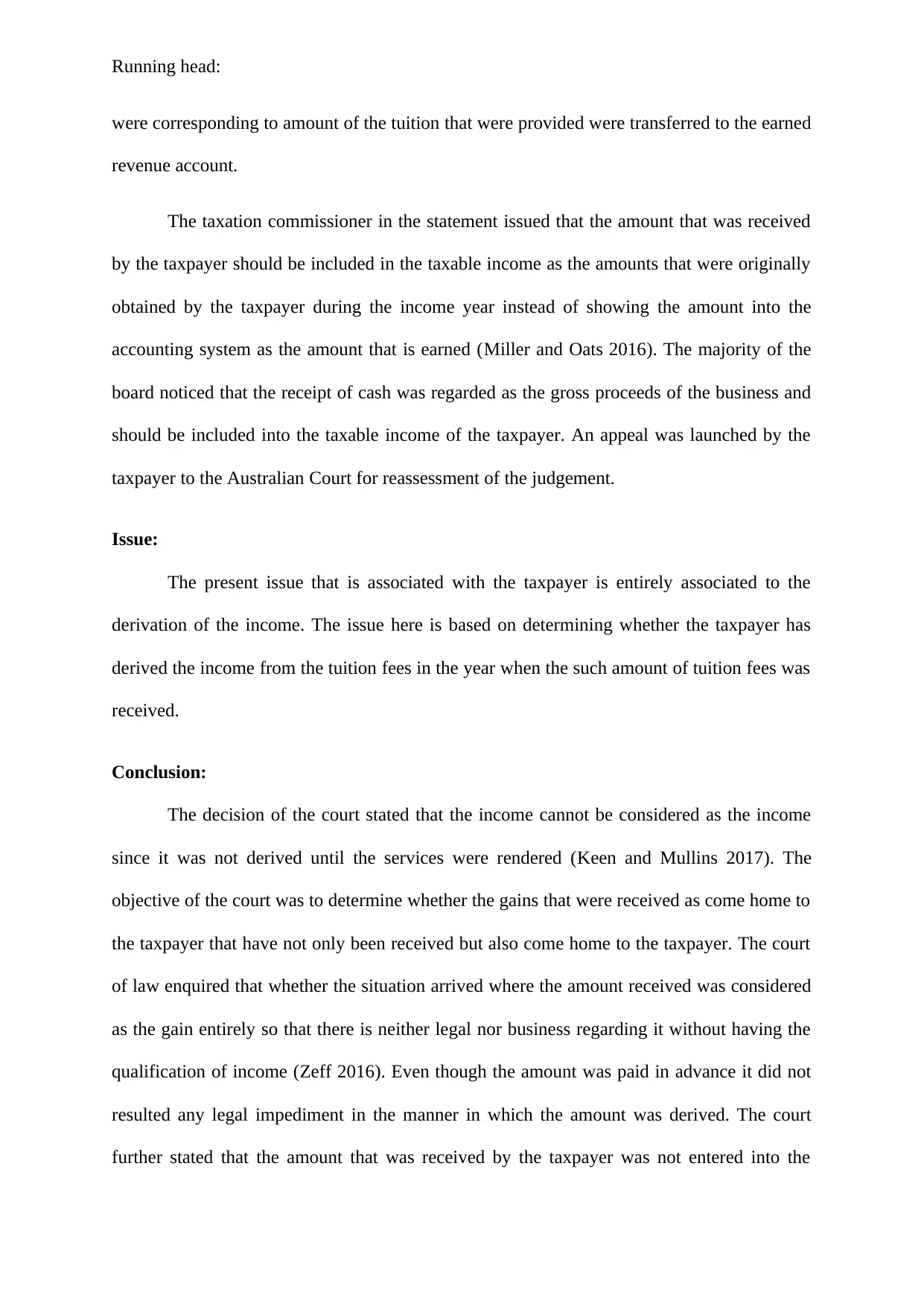
Running head:
were corresponding to amount of the tuition that were provided were transferred to the earned
revenue account.
The taxation commissioner in the statement issued that the amount that was received
by the taxpayer should be included in the taxable income as the amounts that were originally
obtained by the taxpayer during the income year instead of showing the amount into the
accounting system as the amount that is earned (Miller and Oats 2016). The majority of the
board noticed that the receipt of cash was regarded as the gross proceeds of the business and
should be included into the taxable income of the taxpayer. An appeal was launched by the
taxpayer to the Australian Court for reassessment of the judgement.
Issue:
The present issue that is associated with the taxpayer is entirely associated to the
derivation of the income. The issue here is based on determining whether the taxpayer has
derived the income from the tuition fees in the year when the such amount of tuition fees was
received.
Conclusion:
The decision of the court stated that the income cannot be considered as the income
since it was not derived until the services were rendered (Keen and Mullins 2017). The
objective of the court was to determine whether the gains that were received as come home to
the taxpayer that have not only been received but also come home to the taxpayer. The court
of law enquired that whether the situation arrived where the amount received was considered
as the gain entirely so that there is neither legal nor business regarding it without having the
qualification of income (Zeff 2016). Even though the amount was paid in advance it did not
resulted any legal impediment in the manner in which the amount was derived. The court
further stated that the amount that was received by the taxpayer was not entered into the
were corresponding to amount of the tuition that were provided were transferred to the earned
revenue account.
The taxation commissioner in the statement issued that the amount that was received
by the taxpayer should be included in the taxable income as the amounts that were originally
obtained by the taxpayer during the income year instead of showing the amount into the
accounting system as the amount that is earned (Miller and Oats 2016). The majority of the
board noticed that the receipt of cash was regarded as the gross proceeds of the business and
should be included into the taxable income of the taxpayer. An appeal was launched by the
taxpayer to the Australian Court for reassessment of the judgement.
Issue:
The present issue that is associated with the taxpayer is entirely associated to the
derivation of the income. The issue here is based on determining whether the taxpayer has
derived the income from the tuition fees in the year when the such amount of tuition fees was
received.
Conclusion:
The decision of the court stated that the income cannot be considered as the income
since it was not derived until the services were rendered (Keen and Mullins 2017). The
objective of the court was to determine whether the gains that were received as come home to
the taxpayer that have not only been received but also come home to the taxpayer. The court
of law enquired that whether the situation arrived where the amount received was considered
as the gain entirely so that there is neither legal nor business regarding it without having the
qualification of income (Zeff 2016). Even though the amount was paid in advance it did not
resulted any legal impediment in the manner in which the amount was derived. The court
further stated that the amount that was received by the taxpayer was not entered into the
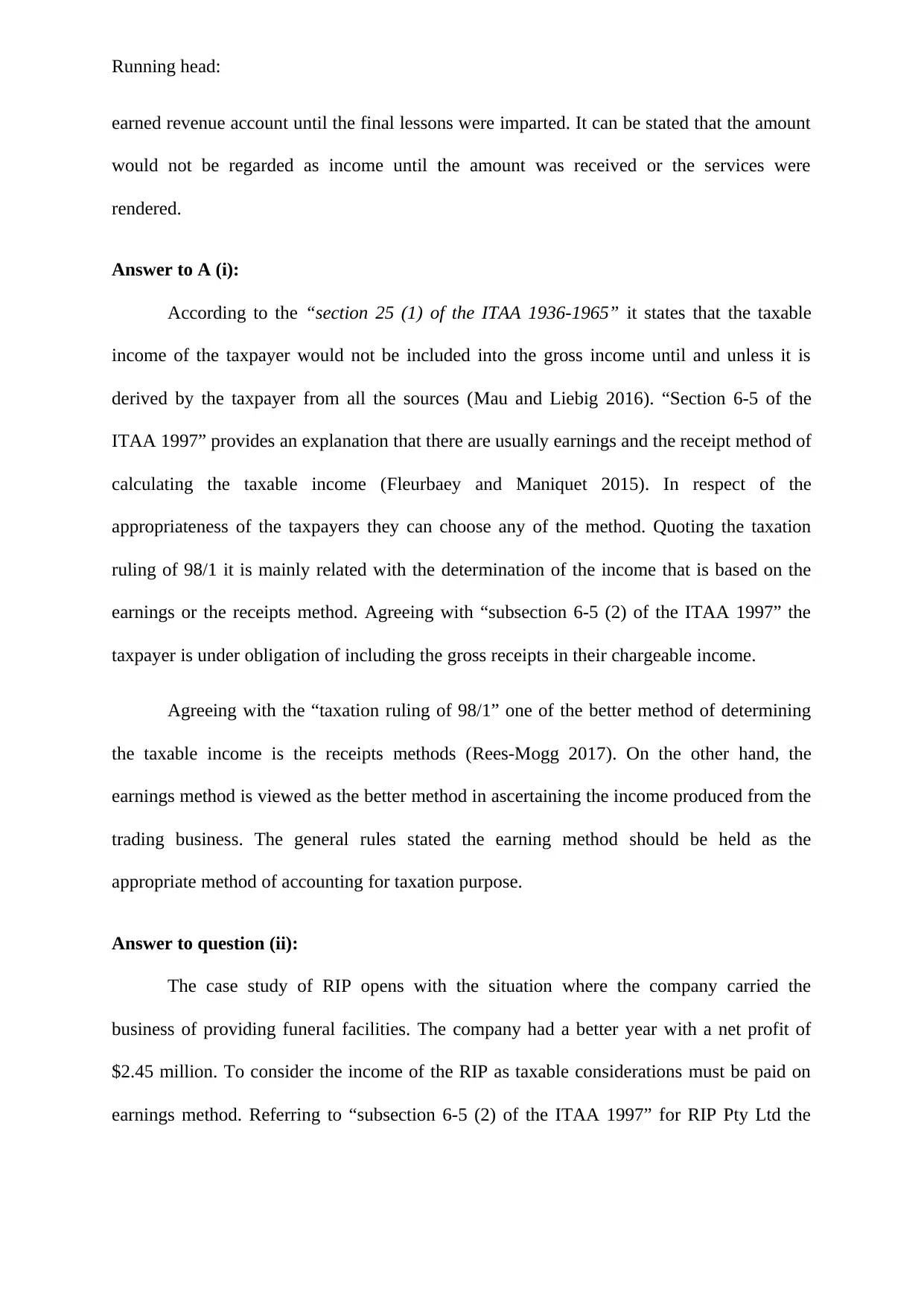
Running head:
earned revenue account until the final lessons were imparted. It can be stated that the amount
would not be regarded as income until the amount was received or the services were
rendered.
Answer to A (i):
According to the “section 25 (1) of the ITAA 1936-1965” it states that the taxable
income of the taxpayer would not be included into the gross income until and unless it is
derived by the taxpayer from all the sources (Mau and Liebig 2016). “Section 6-5 of the
ITAA 1997” provides an explanation that there are usually earnings and the receipt method of
calculating the taxable income (Fleurbaey and Maniquet 2015). In respect of the
appropriateness of the taxpayers they can choose any of the method. Quoting the taxation
ruling of 98/1 it is mainly related with the determination of the income that is based on the
earnings or the receipts method. Agreeing with “subsection 6-5 (2) of the ITAA 1997” the
taxpayer is under obligation of including the gross receipts in their chargeable income.
Agreeing with the “taxation ruling of 98/1” one of the better method of determining
the taxable income is the receipts methods (Rees-Mogg 2017). On the other hand, the
earnings method is viewed as the better method in ascertaining the income produced from the
trading business. The general rules stated the earning method should be held as the
appropriate method of accounting for taxation purpose.
Answer to question (ii):
The case study of RIP opens with the situation where the company carried the
business of providing funeral facilities. The company had a better year with a net profit of
$2.45 million. To consider the income of the RIP as taxable considerations must be paid on
earnings method. Referring to “subsection 6-5 (2) of the ITAA 1997” for RIP Pty Ltd the
earned revenue account until the final lessons were imparted. It can be stated that the amount
would not be regarded as income until the amount was received or the services were
rendered.
Answer to A (i):
According to the “section 25 (1) of the ITAA 1936-1965” it states that the taxable
income of the taxpayer would not be included into the gross income until and unless it is
derived by the taxpayer from all the sources (Mau and Liebig 2016). “Section 6-5 of the
ITAA 1997” provides an explanation that there are usually earnings and the receipt method of
calculating the taxable income (Fleurbaey and Maniquet 2015). In respect of the
appropriateness of the taxpayers they can choose any of the method. Quoting the taxation
ruling of 98/1 it is mainly related with the determination of the income that is based on the
earnings or the receipts method. Agreeing with “subsection 6-5 (2) of the ITAA 1997” the
taxpayer is under obligation of including the gross receipts in their chargeable income.
Agreeing with the “taxation ruling of 98/1” one of the better method of determining
the taxable income is the receipts methods (Rees-Mogg 2017). On the other hand, the
earnings method is viewed as the better method in ascertaining the income produced from the
trading business. The general rules stated the earning method should be held as the
appropriate method of accounting for taxation purpose.
Answer to question (ii):
The case study of RIP opens with the situation where the company carried the
business of providing funeral facilities. The company had a better year with a net profit of
$2.45 million. To consider the income of the RIP as taxable considerations must be paid on
earnings method. Referring to “subsection 6-5 (2) of the ITAA 1997” for RIP Pty Ltd the
Secure Best Marks with AI Grader
Need help grading? Try our AI Grader for instant feedback on your assignments.
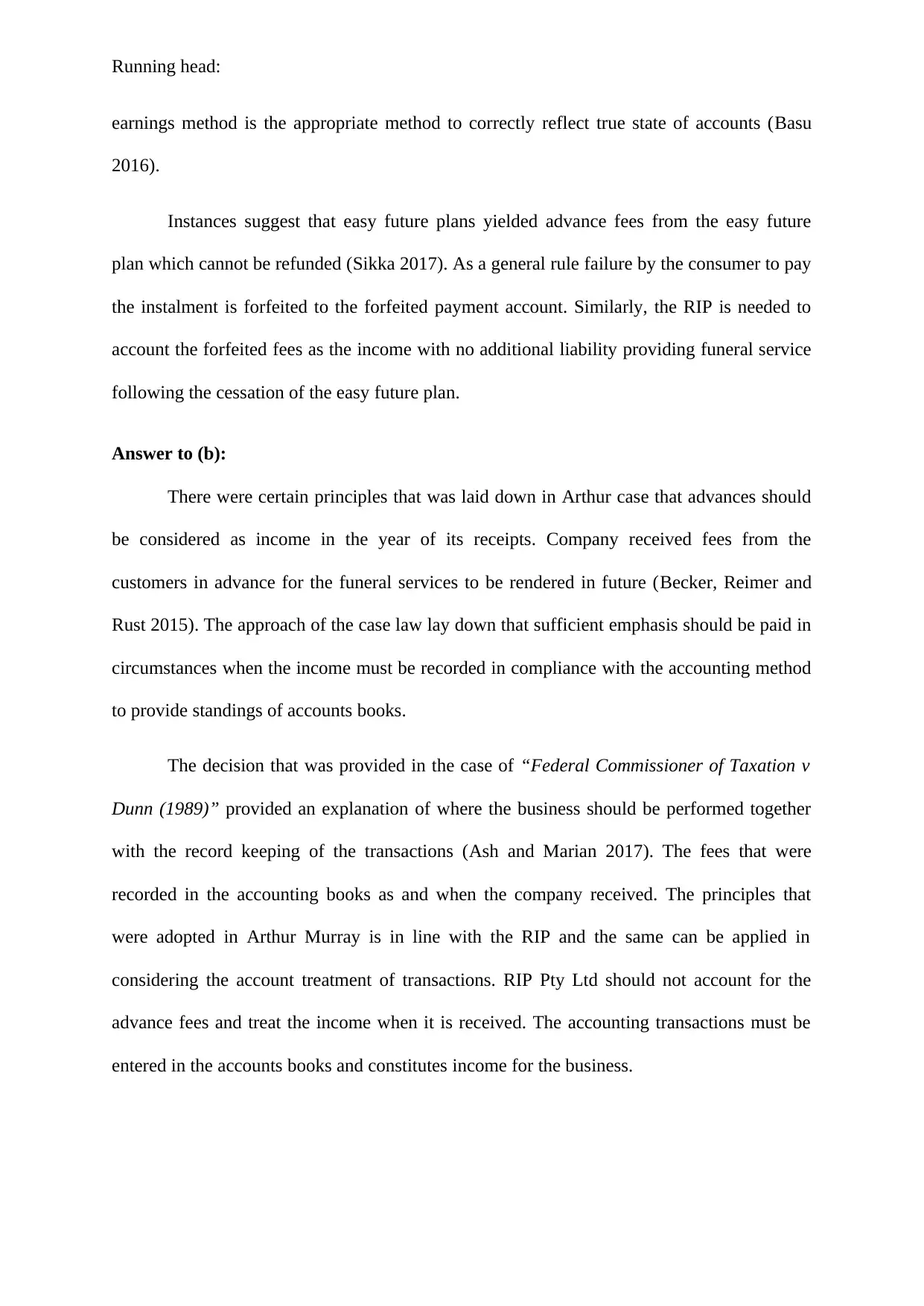
Running head:
earnings method is the appropriate method to correctly reflect true state of accounts (Basu
2016).
Instances suggest that easy future plans yielded advance fees from the easy future
plan which cannot be refunded (Sikka 2017). As a general rule failure by the consumer to pay
the instalment is forfeited to the forfeited payment account. Similarly, the RIP is needed to
account the forfeited fees as the income with no additional liability providing funeral service
following the cessation of the easy future plan.
Answer to (b):
There were certain principles that was laid down in Arthur case that advances should
be considered as income in the year of its receipts. Company received fees from the
customers in advance for the funeral services to be rendered in future (Becker, Reimer and
Rust 2015). The approach of the case law lay down that sufficient emphasis should be paid in
circumstances when the income must be recorded in compliance with the accounting method
to provide standings of accounts books.
The decision that was provided in the case of “Federal Commissioner of Taxation v
Dunn (1989)” provided an explanation of where the business should be performed together
with the record keeping of the transactions (Ash and Marian 2017). The fees that were
recorded in the accounting books as and when the company received. The principles that
were adopted in Arthur Murray is in line with the RIP and the same can be applied in
considering the account treatment of transactions. RIP Pty Ltd should not account for the
advance fees and treat the income when it is received. The accounting transactions must be
entered in the accounts books and constitutes income for the business.
earnings method is the appropriate method to correctly reflect true state of accounts (Basu
2016).
Instances suggest that easy future plans yielded advance fees from the easy future
plan which cannot be refunded (Sikka 2017). As a general rule failure by the consumer to pay
the instalment is forfeited to the forfeited payment account. Similarly, the RIP is needed to
account the forfeited fees as the income with no additional liability providing funeral service
following the cessation of the easy future plan.
Answer to (b):
There were certain principles that was laid down in Arthur case that advances should
be considered as income in the year of its receipts. Company received fees from the
customers in advance for the funeral services to be rendered in future (Becker, Reimer and
Rust 2015). The approach of the case law lay down that sufficient emphasis should be paid in
circumstances when the income must be recorded in compliance with the accounting method
to provide standings of accounts books.
The decision that was provided in the case of “Federal Commissioner of Taxation v
Dunn (1989)” provided an explanation of where the business should be performed together
with the record keeping of the transactions (Ash and Marian 2017). The fees that were
recorded in the accounting books as and when the company received. The principles that
were adopted in Arthur Murray is in line with the RIP and the same can be applied in
considering the account treatment of transactions. RIP Pty Ltd should not account for the
advance fees and treat the income when it is received. The accounting transactions must be
entered in the accounts books and constitutes income for the business.
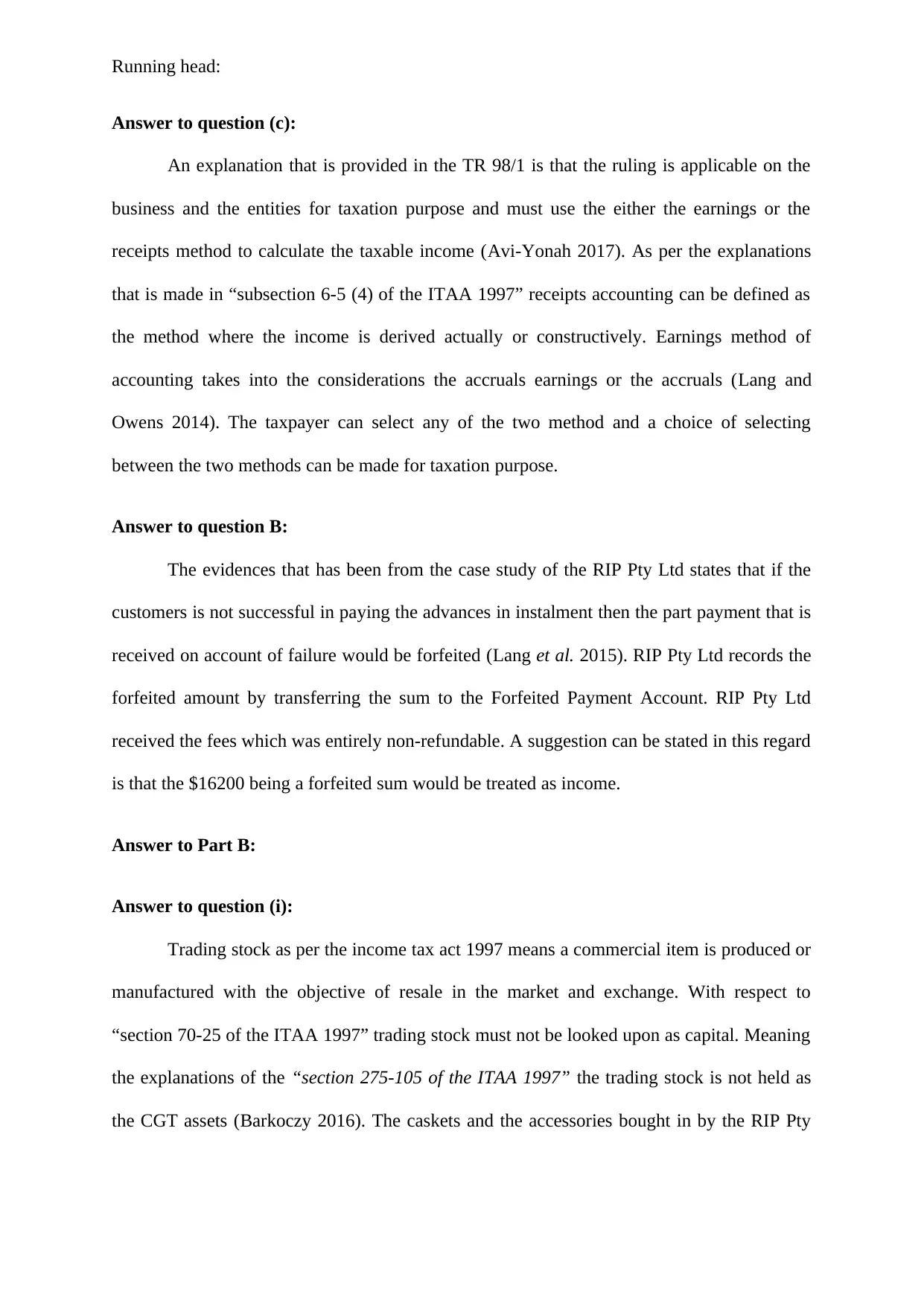
Running head:
Answer to question (c):
An explanation that is provided in the TR 98/1 is that the ruling is applicable on the
business and the entities for taxation purpose and must use the either the earnings or the
receipts method to calculate the taxable income (Avi-Yonah 2017). As per the explanations
that is made in “subsection 6-5 (4) of the ITAA 1997” receipts accounting can be defined as
the method where the income is derived actually or constructively. Earnings method of
accounting takes into the considerations the accruals earnings or the accruals (Lang and
Owens 2014). The taxpayer can select any of the two method and a choice of selecting
between the two methods can be made for taxation purpose.
Answer to question B:
The evidences that has been from the case study of the RIP Pty Ltd states that if the
customers is not successful in paying the advances in instalment then the part payment that is
received on account of failure would be forfeited (Lang et al. 2015). RIP Pty Ltd records the
forfeited amount by transferring the sum to the Forfeited Payment Account. RIP Pty Ltd
received the fees which was entirely non-refundable. A suggestion can be stated in this regard
is that the $16200 being a forfeited sum would be treated as income.
Answer to Part B:
Answer to question (i):
Trading stock as per the income tax act 1997 means a commercial item is produced or
manufactured with the objective of resale in the market and exchange. With respect to
“section 70-25 of the ITAA 1997” trading stock must not be looked upon as capital. Meaning
the explanations of the “section 275-105 of the ITAA 1997” the trading stock is not held as
the CGT assets (Barkoczy 2016). The caskets and the accessories bought in by the RIP Pty
Answer to question (c):
An explanation that is provided in the TR 98/1 is that the ruling is applicable on the
business and the entities for taxation purpose and must use the either the earnings or the
receipts method to calculate the taxable income (Avi-Yonah 2017). As per the explanations
that is made in “subsection 6-5 (4) of the ITAA 1997” receipts accounting can be defined as
the method where the income is derived actually or constructively. Earnings method of
accounting takes into the considerations the accruals earnings or the accruals (Lang and
Owens 2014). The taxpayer can select any of the two method and a choice of selecting
between the two methods can be made for taxation purpose.
Answer to question B:
The evidences that has been from the case study of the RIP Pty Ltd states that if the
customers is not successful in paying the advances in instalment then the part payment that is
received on account of failure would be forfeited (Lang et al. 2015). RIP Pty Ltd records the
forfeited amount by transferring the sum to the Forfeited Payment Account. RIP Pty Ltd
received the fees which was entirely non-refundable. A suggestion can be stated in this regard
is that the $16200 being a forfeited sum would be treated as income.
Answer to Part B:
Answer to question (i):
Trading stock as per the income tax act 1997 means a commercial item is produced or
manufactured with the objective of resale in the market and exchange. With respect to
“section 70-25 of the ITAA 1997” trading stock must not be looked upon as capital. Meaning
the explanations of the “section 275-105 of the ITAA 1997” the trading stock is not held as
the CGT assets (Barkoczy 2016). The caskets and the accessories bought in by the RIP Pty
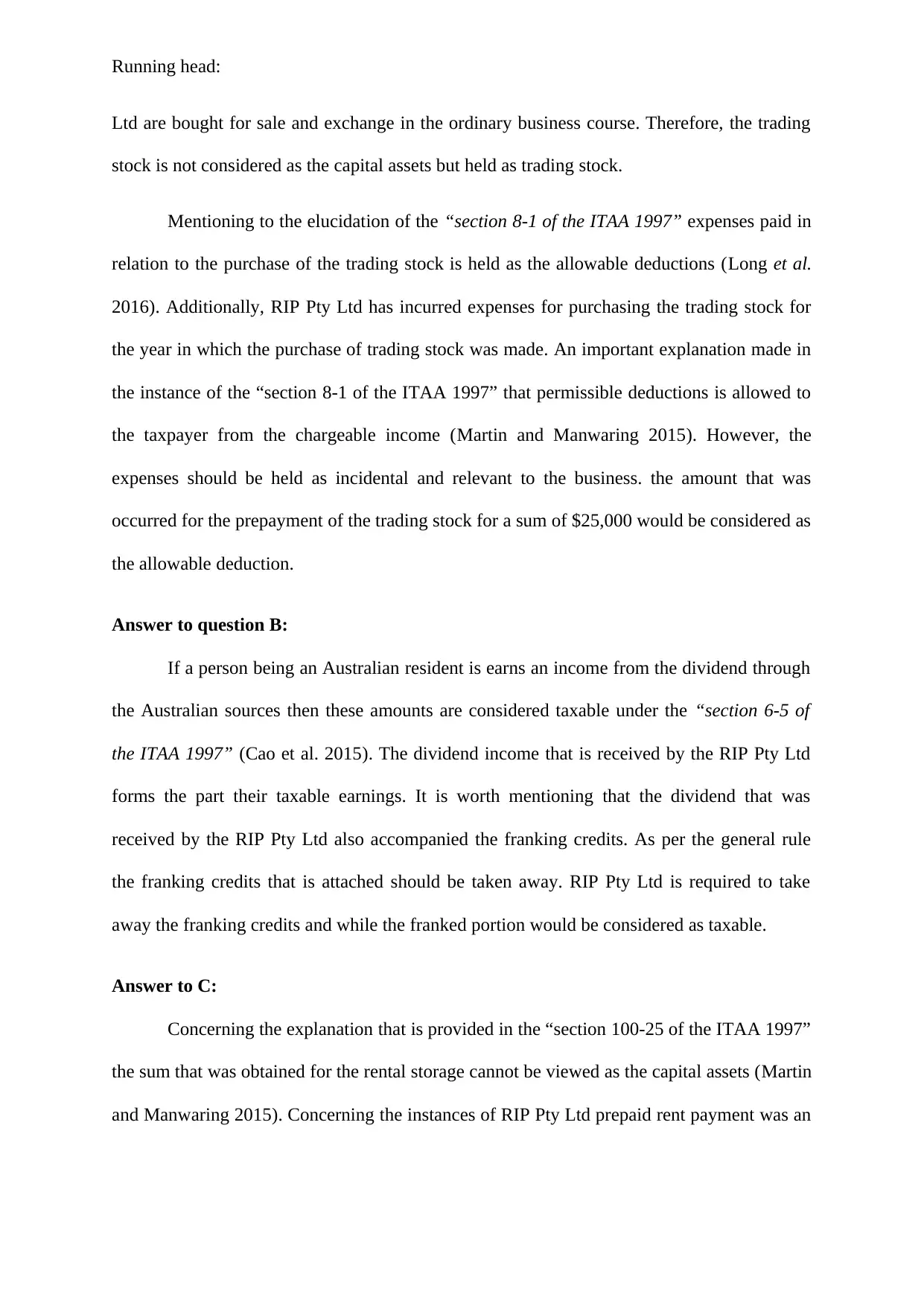
Running head:
Ltd are bought for sale and exchange in the ordinary business course. Therefore, the trading
stock is not considered as the capital assets but held as trading stock.
Mentioning to the elucidation of the “section 8-1 of the ITAA 1997” expenses paid in
relation to the purchase of the trading stock is held as the allowable deductions (Long et al.
2016). Additionally, RIP Pty Ltd has incurred expenses for purchasing the trading stock for
the year in which the purchase of trading stock was made. An important explanation made in
the instance of the “section 8-1 of the ITAA 1997” that permissible deductions is allowed to
the taxpayer from the chargeable income (Martin and Manwaring 2015). However, the
expenses should be held as incidental and relevant to the business. the amount that was
occurred for the prepayment of the trading stock for a sum of $25,000 would be considered as
the allowable deduction.
Answer to question B:
If a person being an Australian resident is earns an income from the dividend through
the Australian sources then these amounts are considered taxable under the “section 6-5 of
the ITAA 1997” (Cao et al. 2015). The dividend income that is received by the RIP Pty Ltd
forms the part their taxable earnings. It is worth mentioning that the dividend that was
received by the RIP Pty Ltd also accompanied the franking credits. As per the general rule
the franking credits that is attached should be taken away. RIP Pty Ltd is required to take
away the franking credits and while the franked portion would be considered as taxable.
Answer to C:
Concerning the explanation that is provided in the “section 100-25 of the ITAA 1997”
the sum that was obtained for the rental storage cannot be viewed as the capital assets (Martin
and Manwaring 2015). Concerning the instances of RIP Pty Ltd prepaid rent payment was an
Ltd are bought for sale and exchange in the ordinary business course. Therefore, the trading
stock is not considered as the capital assets but held as trading stock.
Mentioning to the elucidation of the “section 8-1 of the ITAA 1997” expenses paid in
relation to the purchase of the trading stock is held as the allowable deductions (Long et al.
2016). Additionally, RIP Pty Ltd has incurred expenses for purchasing the trading stock for
the year in which the purchase of trading stock was made. An important explanation made in
the instance of the “section 8-1 of the ITAA 1997” that permissible deductions is allowed to
the taxpayer from the chargeable income (Martin and Manwaring 2015). However, the
expenses should be held as incidental and relevant to the business. the amount that was
occurred for the prepayment of the trading stock for a sum of $25,000 would be considered as
the allowable deduction.
Answer to question B:
If a person being an Australian resident is earns an income from the dividend through
the Australian sources then these amounts are considered taxable under the “section 6-5 of
the ITAA 1997” (Cao et al. 2015). The dividend income that is received by the RIP Pty Ltd
forms the part their taxable earnings. It is worth mentioning that the dividend that was
received by the RIP Pty Ltd also accompanied the franking credits. As per the general rule
the franking credits that is attached should be taken away. RIP Pty Ltd is required to take
away the franking credits and while the franked portion would be considered as taxable.
Answer to C:
Concerning the explanation that is provided in the “section 100-25 of the ITAA 1997”
the sum that was obtained for the rental storage cannot be viewed as the capital assets (Martin
and Manwaring 2015). Concerning the instances of RIP Pty Ltd prepaid rent payment was an
Paraphrase This Document
Need a fresh take? Get an instant paraphrase of this document with our AI Paraphraser
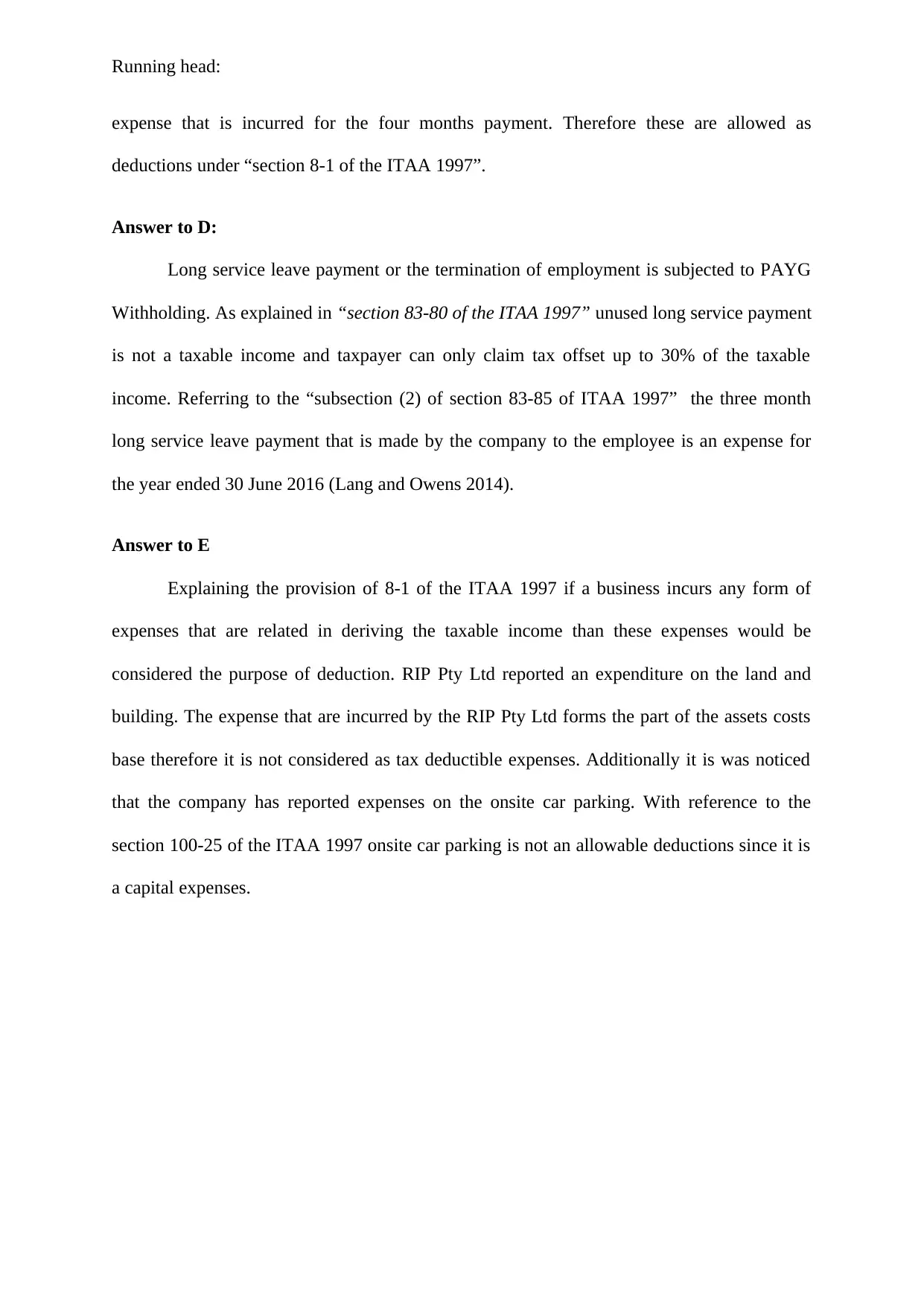
Running head:
expense that is incurred for the four months payment. Therefore these are allowed as
deductions under “section 8-1 of the ITAA 1997”.
Answer to D:
Long service leave payment or the termination of employment is subjected to PAYG
Withholding. As explained in “section 83-80 of the ITAA 1997” unused long service payment
is not a taxable income and taxpayer can only claim tax offset up to 30% of the taxable
income. Referring to the “subsection (2) of section 83-85 of ITAA 1997” the three month
long service leave payment that is made by the company to the employee is an expense for
the year ended 30 June 2016 (Lang and Owens 2014).
Answer to E
Explaining the provision of 8-1 of the ITAA 1997 if a business incurs any form of
expenses that are related in deriving the taxable income than these expenses would be
considered the purpose of deduction. RIP Pty Ltd reported an expenditure on the land and
building. The expense that are incurred by the RIP Pty Ltd forms the part of the assets costs
base therefore it is not considered as tax deductible expenses. Additionally it is was noticed
that the company has reported expenses on the onsite car parking. With reference to the
section 100-25 of the ITAA 1997 onsite car parking is not an allowable deductions since it is
a capital expenses.
expense that is incurred for the four months payment. Therefore these are allowed as
deductions under “section 8-1 of the ITAA 1997”.
Answer to D:
Long service leave payment or the termination of employment is subjected to PAYG
Withholding. As explained in “section 83-80 of the ITAA 1997” unused long service payment
is not a taxable income and taxpayer can only claim tax offset up to 30% of the taxable
income. Referring to the “subsection (2) of section 83-85 of ITAA 1997” the three month
long service leave payment that is made by the company to the employee is an expense for
the year ended 30 June 2016 (Lang and Owens 2014).
Answer to E
Explaining the provision of 8-1 of the ITAA 1997 if a business incurs any form of
expenses that are related in deriving the taxable income than these expenses would be
considered the purpose of deduction. RIP Pty Ltd reported an expenditure on the land and
building. The expense that are incurred by the RIP Pty Ltd forms the part of the assets costs
base therefore it is not considered as tax deductible expenses. Additionally it is was noticed
that the company has reported expenses on the onsite car parking. With reference to the
section 100-25 of the ITAA 1997 onsite car parking is not an allowable deductions since it is
a capital expenses.
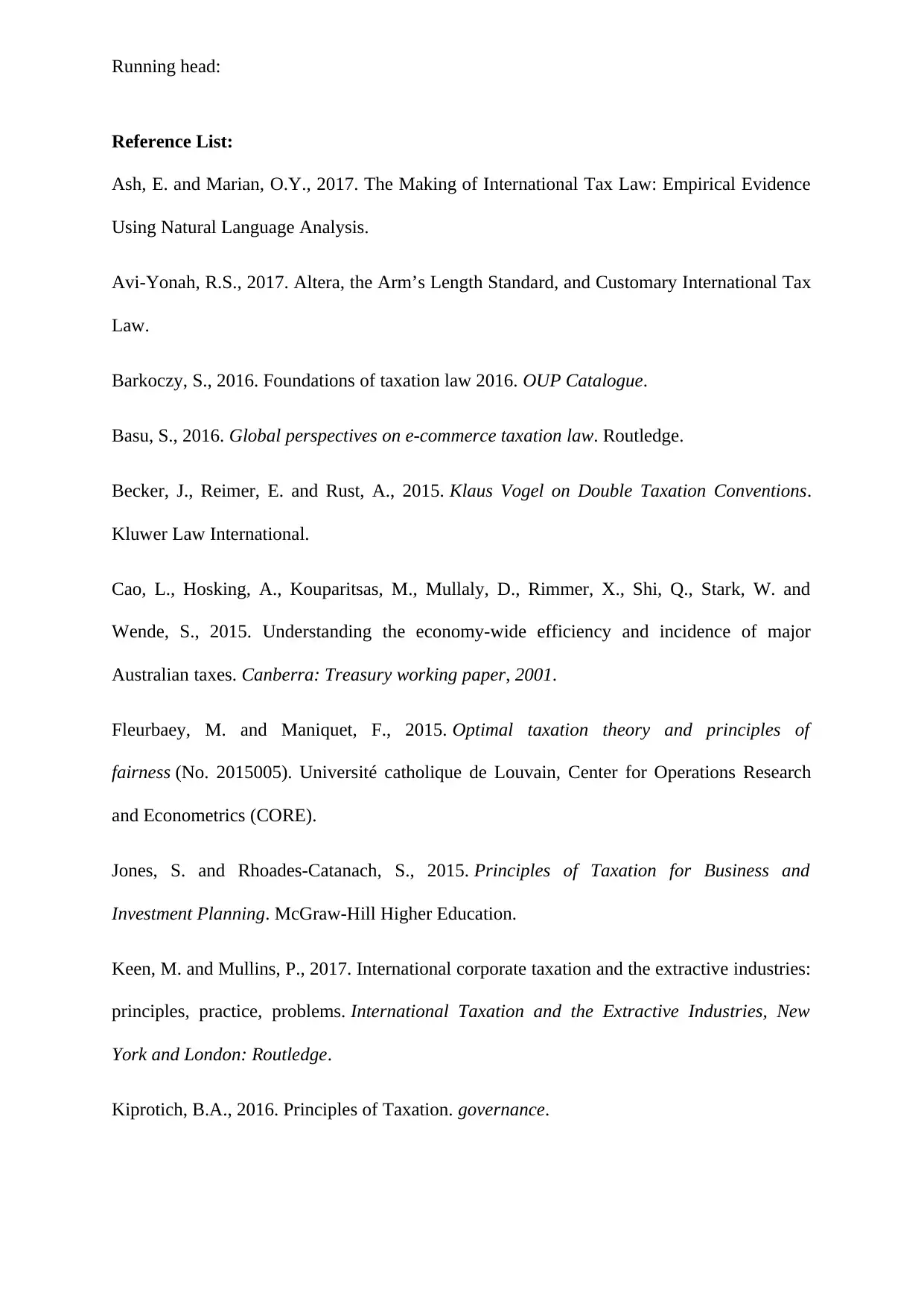
Running head:
Reference List:
Ash, E. and Marian, O.Y., 2017. The Making of International Tax Law: Empirical Evidence
Using Natural Language Analysis.
Avi-Yonah, R.S., 2017. Altera, the Arm’s Length Standard, and Customary International Tax
Law.
Barkoczy, S., 2016. Foundations of taxation law 2016. OUP Catalogue.
Basu, S., 2016. Global perspectives on e-commerce taxation law. Routledge.
Becker, J., Reimer, E. and Rust, A., 2015. Klaus Vogel on Double Taxation Conventions.
Kluwer Law International.
Cao, L., Hosking, A., Kouparitsas, M., Mullaly, D., Rimmer, X., Shi, Q., Stark, W. and
Wende, S., 2015. Understanding the economy-wide efficiency and incidence of major
Australian taxes. Canberra: Treasury working paper, 2001.
Fleurbaey, M. and Maniquet, F., 2015. Optimal taxation theory and principles of
fairness (No. 2015005). Université catholique de Louvain, Center for Operations Research
and Econometrics (CORE).
Jones, S. and Rhoades-Catanach, S., 2015. Principles of Taxation for Business and
Investment Planning. McGraw-Hill Higher Education.
Keen, M. and Mullins, P., 2017. International corporate taxation and the extractive industries:
principles, practice, problems. International Taxation and the Extractive Industries, New
York and London: Routledge.
Kiprotich, B.A., 2016. Principles of Taxation. governance.
Reference List:
Ash, E. and Marian, O.Y., 2017. The Making of International Tax Law: Empirical Evidence
Using Natural Language Analysis.
Avi-Yonah, R.S., 2017. Altera, the Arm’s Length Standard, and Customary International Tax
Law.
Barkoczy, S., 2016. Foundations of taxation law 2016. OUP Catalogue.
Basu, S., 2016. Global perspectives on e-commerce taxation law. Routledge.
Becker, J., Reimer, E. and Rust, A., 2015. Klaus Vogel on Double Taxation Conventions.
Kluwer Law International.
Cao, L., Hosking, A., Kouparitsas, M., Mullaly, D., Rimmer, X., Shi, Q., Stark, W. and
Wende, S., 2015. Understanding the economy-wide efficiency and incidence of major
Australian taxes. Canberra: Treasury working paper, 2001.
Fleurbaey, M. and Maniquet, F., 2015. Optimal taxation theory and principles of
fairness (No. 2015005). Université catholique de Louvain, Center for Operations Research
and Econometrics (CORE).
Jones, S. and Rhoades-Catanach, S., 2015. Principles of Taxation for Business and
Investment Planning. McGraw-Hill Higher Education.
Keen, M. and Mullins, P., 2017. International corporate taxation and the extractive industries:
principles, practice, problems. International Taxation and the Extractive Industries, New
York and London: Routledge.
Kiprotich, B.A., 2016. Principles of Taxation. governance.
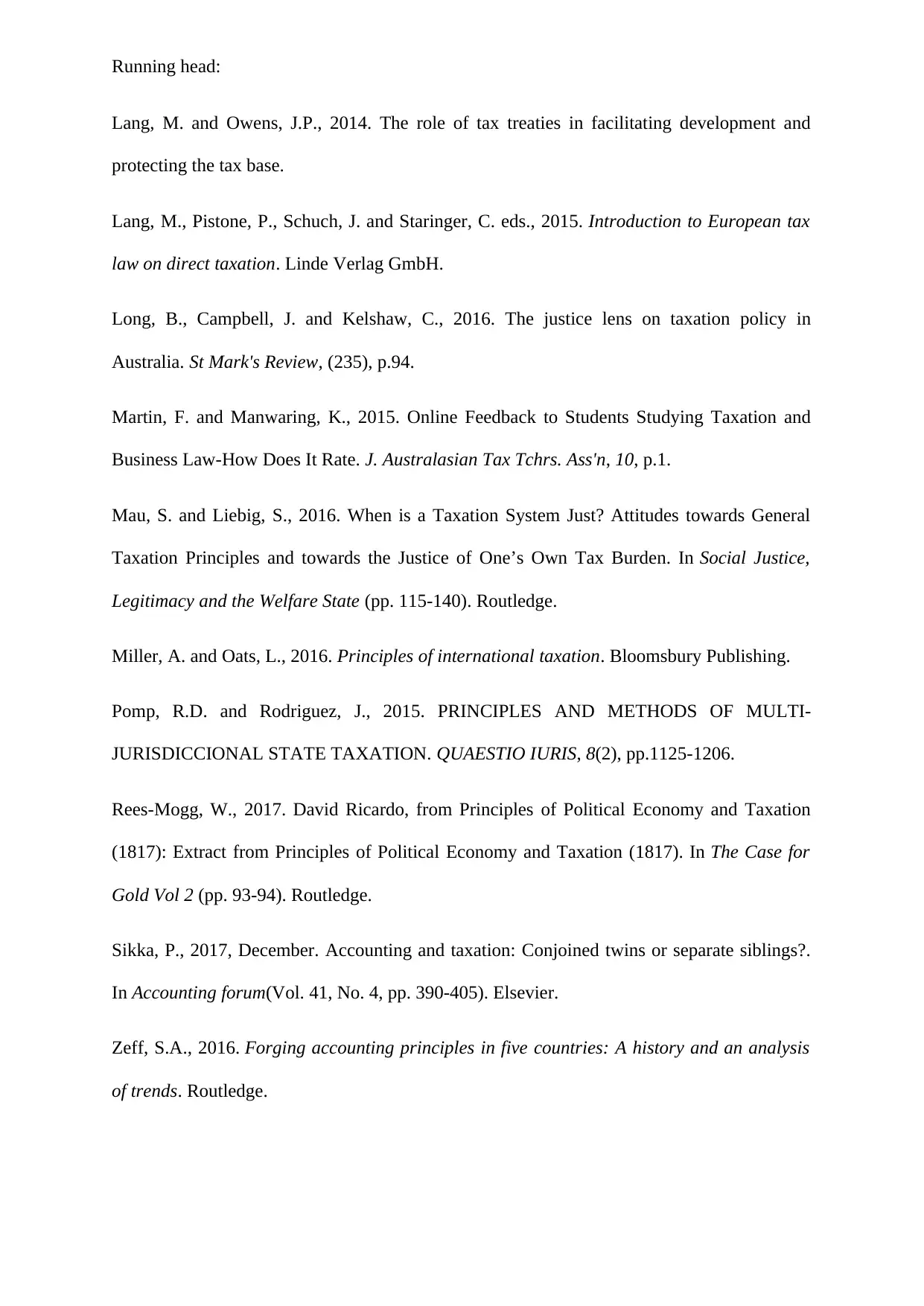
Running head:
Lang, M. and Owens, J.P., 2014. The role of tax treaties in facilitating development and
protecting the tax base.
Lang, M., Pistone, P., Schuch, J. and Staringer, C. eds., 2015. Introduction to European tax
law on direct taxation. Linde Verlag GmbH.
Long, B., Campbell, J. and Kelshaw, C., 2016. The justice lens on taxation policy in
Australia. St Mark's Review, (235), p.94.
Martin, F. and Manwaring, K., 2015. Online Feedback to Students Studying Taxation and
Business Law-How Does It Rate. J. Australasian Tax Tchrs. Ass'n, 10, p.1.
Mau, S. and Liebig, S., 2016. When is a Taxation System Just? Attitudes towards General
Taxation Principles and towards the Justice of One’s Own Tax Burden. In Social Justice,
Legitimacy and the Welfare State (pp. 115-140). Routledge.
Miller, A. and Oats, L., 2016. Principles of international taxation. Bloomsbury Publishing.
Pomp, R.D. and Rodriguez, J., 2015. PRINCIPLES AND METHODS OF MULTI-
JURISDICCIONAL STATE TAXATION. QUAESTIO IURIS, 8(2), pp.1125-1206.
Rees-Mogg, W., 2017. David Ricardo, from Principles of Political Economy and Taxation
(1817): Extract from Principles of Political Economy and Taxation (1817). In The Case for
Gold Vol 2 (pp. 93-94). Routledge.
Sikka, P., 2017, December. Accounting and taxation: Conjoined twins or separate siblings?.
In Accounting forum(Vol. 41, No. 4, pp. 390-405). Elsevier.
Zeff, S.A., 2016. Forging accounting principles in five countries: A history and an analysis
of trends. Routledge.
Lang, M. and Owens, J.P., 2014. The role of tax treaties in facilitating development and
protecting the tax base.
Lang, M., Pistone, P., Schuch, J. and Staringer, C. eds., 2015. Introduction to European tax
law on direct taxation. Linde Verlag GmbH.
Long, B., Campbell, J. and Kelshaw, C., 2016. The justice lens on taxation policy in
Australia. St Mark's Review, (235), p.94.
Martin, F. and Manwaring, K., 2015. Online Feedback to Students Studying Taxation and
Business Law-How Does It Rate. J. Australasian Tax Tchrs. Ass'n, 10, p.1.
Mau, S. and Liebig, S., 2016. When is a Taxation System Just? Attitudes towards General
Taxation Principles and towards the Justice of One’s Own Tax Burden. In Social Justice,
Legitimacy and the Welfare State (pp. 115-140). Routledge.
Miller, A. and Oats, L., 2016. Principles of international taxation. Bloomsbury Publishing.
Pomp, R.D. and Rodriguez, J., 2015. PRINCIPLES AND METHODS OF MULTI-
JURISDICCIONAL STATE TAXATION. QUAESTIO IURIS, 8(2), pp.1125-1206.
Rees-Mogg, W., 2017. David Ricardo, from Principles of Political Economy and Taxation
(1817): Extract from Principles of Political Economy and Taxation (1817). In The Case for
Gold Vol 2 (pp. 93-94). Routledge.
Sikka, P., 2017, December. Accounting and taxation: Conjoined twins or separate siblings?.
In Accounting forum(Vol. 41, No. 4, pp. 390-405). Elsevier.
Zeff, S.A., 2016. Forging accounting principles in five countries: A history and an analysis
of trends. Routledge.
1 out of 10
Related Documents
Your All-in-One AI-Powered Toolkit for Academic Success.
+13062052269
info@desklib.com
Available 24*7 on WhatsApp / Email
![[object Object]](/_next/static/media/star-bottom.7253800d.svg)
Unlock your academic potential
© 2024 | Zucol Services PVT LTD | All rights reserved.



